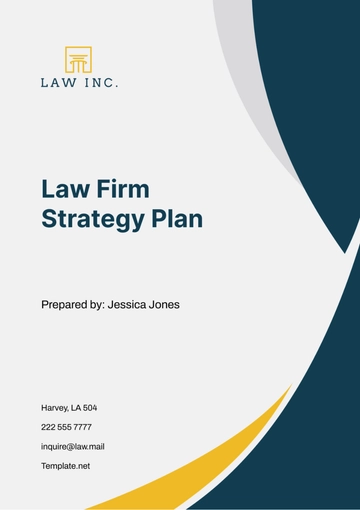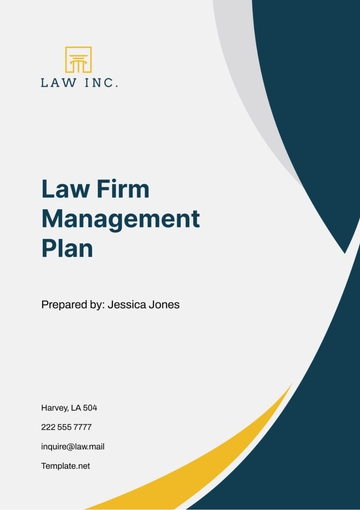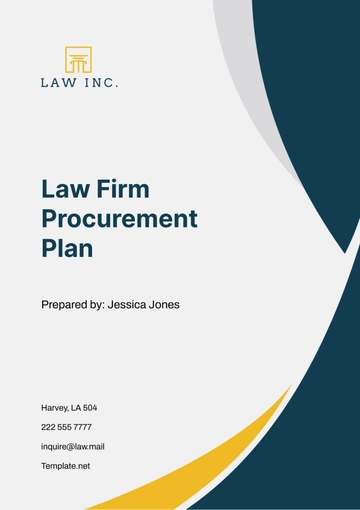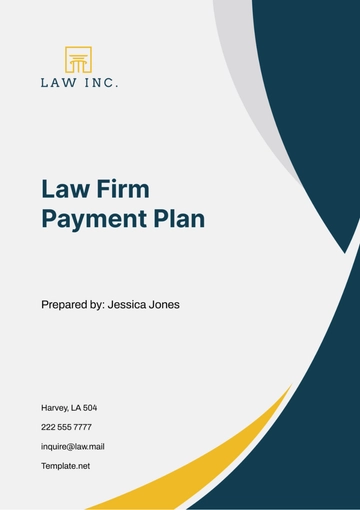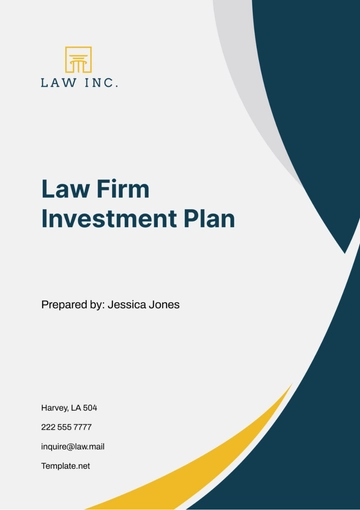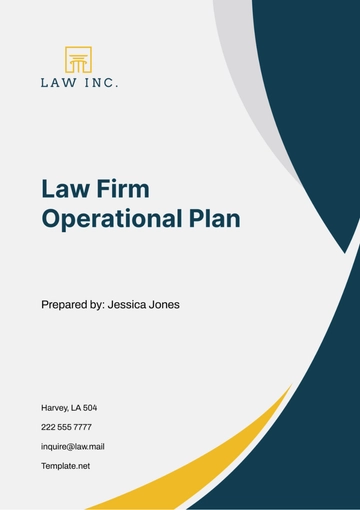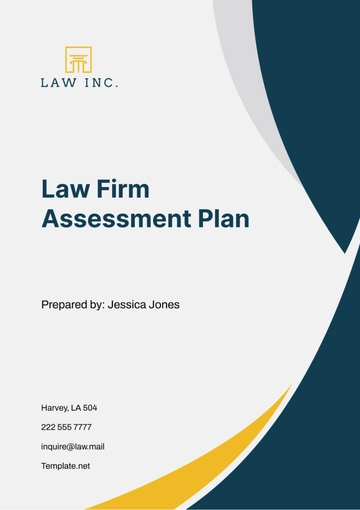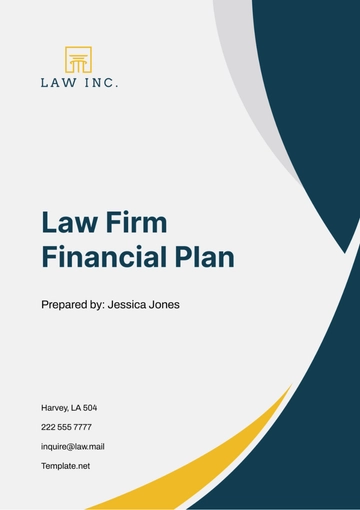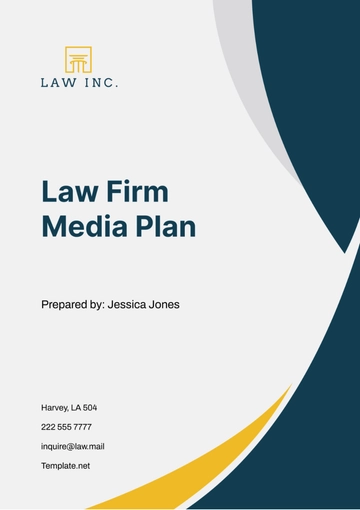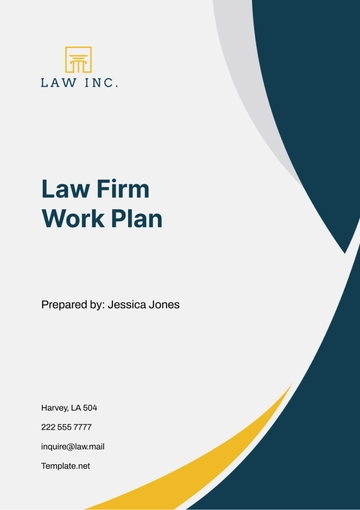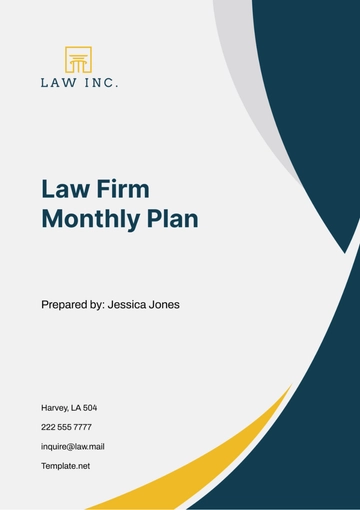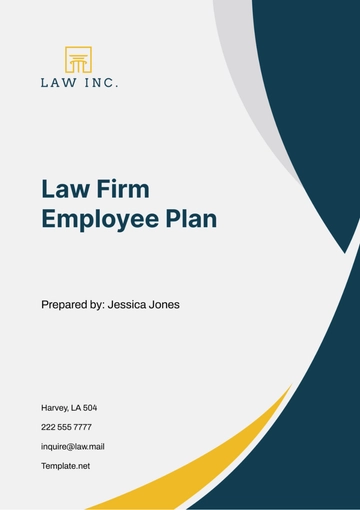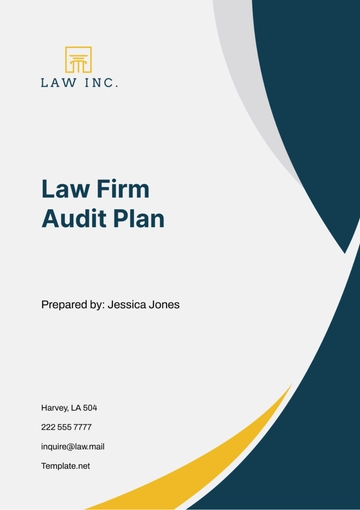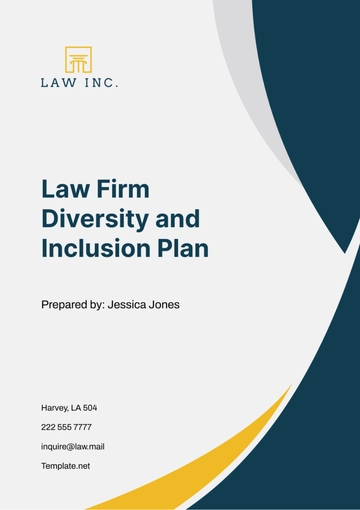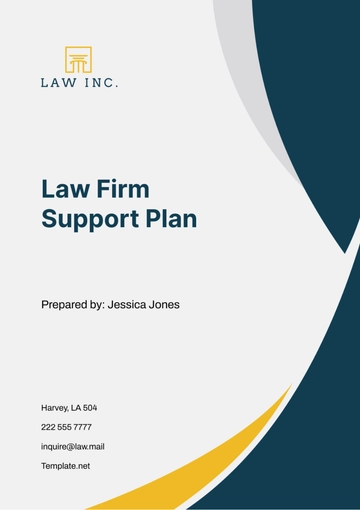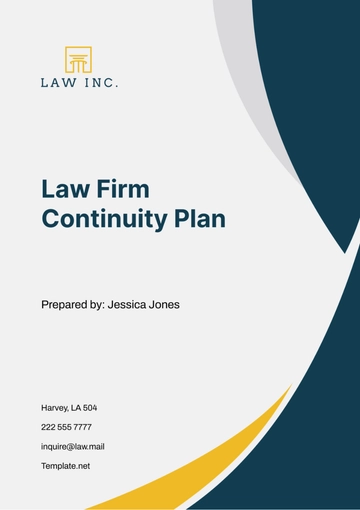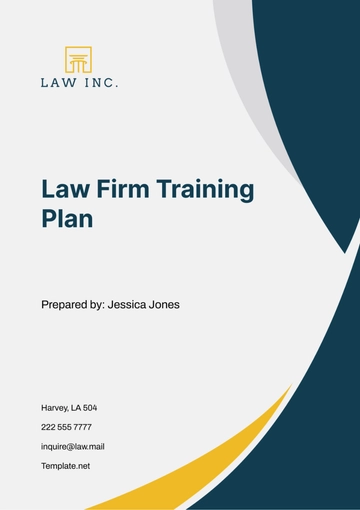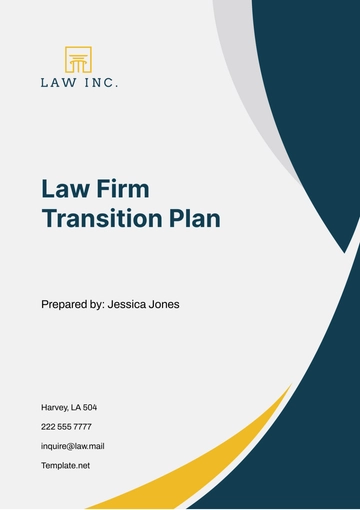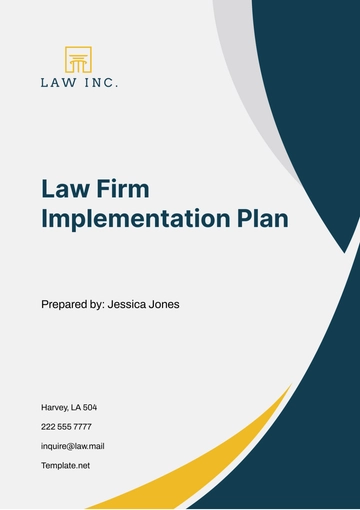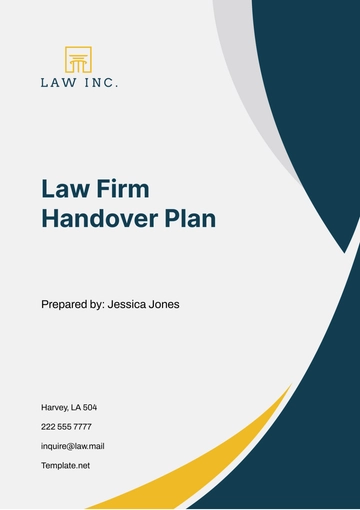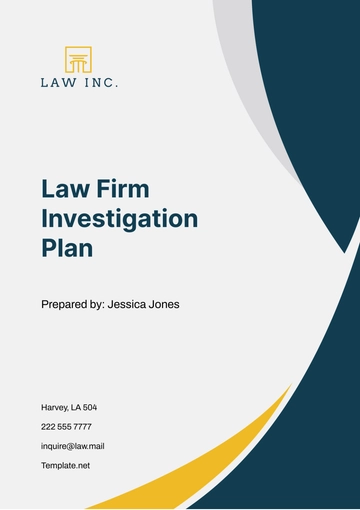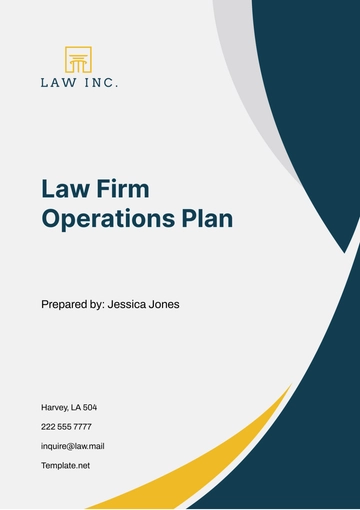Free Law Firm Financial Plan

Introduction
The financial plan for [Your Company Name] serves as a foundational element in guiding the firm's strategic decisions, supporting sustainable growth, and ensuring financial stability. This document outlines the structure of our financial goals, detailing revenue targets, budget allocation, cost management, capital investments, and financial monitoring.
Revenue Targets and Projections
This section establishes the firm's revenue targets over the next few years, reflecting both the ambition and the realistic growth projections based on the firm’s current trajectory and market opportunities.
Revenue Targets and Growth Projections:
Year | Projected Revenue | Growth Rate |
|---|---|---|
2051 | $5,000,000 | 10% |
2052 | $5,500,000 | 10% |
2053 | $6,050,000 | 10% |
Key Drivers:
The key drivers outlined in the financial plan are crucial elements that will significantly impact [Your Company Name]'s ability to achieve its revenue targets. Each driver is strategically chosen to enhance the firm’s operational capabilities and market positioning.
Expanded Client Base, New Services: Expanding the client base involves targeting new demographics and penetrating additional markets, potentially through geographic expansion. Introducing new services, such as alternative dispute resolution or specialized consultancy in emerging legal areas like technology or environmental law, will cater to a broader client base and meet evolving market demands.
Increased Marketing Efforts: Enhancing marketing efforts encompasses a range of activities designed to raise the firm’s profile and attract new clients. By increasing its visibility and actively engaging with potential clients through these channels, the firm aims to enhance its market presence, which is directly linked to revenue growth. Targeted marketing campaigns will also be tailored to highlight the firm's new services, ensuring that potential clients are aware of the firm's expanded offerings.
Technological Advancements: Investing in technological advancements is essential for increasing operational efficiency and improving client services. These technologies will streamline internal processes, reduce overhead costs, and enhance the accuracy and speed of service delivery. Embracing innovative technology solutions will not only improve service quality but also position the firm as a forward-thinking, modern legal practice.
The firm’s expected growth trajectory, projecting an annual revenue increase of [10%] each year. The key drivers listed, such as expanded client base and new services, underline the firm's strategic actions to capture more market share and diversify its offerings. This table serves as a benchmark for setting realistic but challenging revenue goals, aligning them with operational plans to foster growth.
Budget Allocation
Efficient budget allocation is critical to supporting various operational needs. This section details how the firm plans to distribute its financial resources across different departments and initiatives.
Budget Allocation for [2051]:
Category | Purpose |
|---|---|
Marketing | Digital campaigns, events, public relations |
Technology | Software upgrades, cybersecurity enhancements |
Personnel | Salaries, training programs, benefits |
Legal Resources | Subscription services, legal databases |
Administrative | Office supplies, utilities, miscellaneous expenses |
Marketing and personnel receive significant portions, emphasizing the firm’s focus on expanding its market presence and investing in its workforce. The allocations are strategically designed to balance growth initiatives and operational sustainability, ensuring that resources are optimally utilized to support the firm's strategic objectives.
Cost Management
Cost management is essential for maintaining financial health and enhancing profitability. This section outlines the strategies that [Your Company Name] will employ to control expenses and improve efficiency.
Strategies for Cost Management:
By implementing regular reviews and negotiating better vendor contracts, the firm aims to keep costs under control and optimize spending. The focus on energy-saving measures and technological improvements further reflects the firm's commitment to long-term sustainability and operational efficiency.
Regular Review of Expenditure Against Budget and Real-Time Adjustments: This practice ensures that any variances are identified early, allowing for real-time adjustments. The use of financial management software will enable automated tracking and reporting, facilitating swift decision-making to prevent budget overruns.
Negotiation of Vendor Contracts to Achieve Better Rates: [Your Company Name] will adopt a strategic approach to vendor negotiations by consolidating purchase orders and seeking long-term contracts to leverage bulk buying and loyalty discounts. The firm will regularly review its supplier list to ensure competitiveness and quality of service.
Implementation of Energy-Saving Measures and Technology to Reduce Utility Costs: The firm will invest in energy-efficient technologies such as LED lighting, programmable thermostats, and high-efficiency heating, ventilation, and air conditioning (HVAC) systems. These investments, though initially costly, will result in significant long-term savings. The adoption of green technologies not only reduces utility costs but also aligns with broader environmental objectives, enhancing the firm's corporate social responsibility profile.
[Your Company Name] aims to optimize its expenditure, ensuring that financial resources are used effectively to support sustainable growth and enhance profitability. These detailed approaches will allow the firm to maintain tight control over its finances, adapt to changing economic conditions, and invest in areas that provide the greatest return on investment.
Capital Investments and Financial Reserves
Investing in the firm’s infrastructure and technology is vital for long-term growth, while maintaining financial reserves ensures preparedness for economic fluctuations. This section details the firm's plans for capital expenditures and reserve allocations.
Planned Investments and Reserves for [2051-2053]:
Year | Investment Type | Amount |
|---|---|---|
2051 | Technology Upgrade | $200,000 |
2052 | Office Expansion | $300,000 |
2053 | Financial Reserves | $500,000 |
The table above specifies the types and purposes of planned investments over the next three years, focusing on technological upgrades and office expansion to support operational capacity and efficiency. The commitment to setting aside significant reserves in [2053] demonstrates prudent financial planning, ensuring that the firm has a buffer to mitigate potential economic shocks.
Capital Structure and Financing Strategy
For [Your Company Name] to achieve its strategic objectives, it is essential to have a well-structured capital and financing strategy. This section outlines how the firm plans to manage its capital resources and finance its operations, including leveraging both equity and debt, maintaining liquidity, and investing in growth opportunities.
Capital Structure Strategy
The capital structure of a law firm is crucial for optimizing its financial stability and operational flexibility. [Your Company Name] aims to maintain a balanced mix of equity and debt, ensuring that it leverages the benefits of both while minimizing financial risks.
Capital Structure and Financing Plan for [2051-2053]:
Year | Notes Payable | Long-Term Debt | Total Capitalization |
|---|---|---|---|
2051 | $500,000 | $1,500,000 | $2,000,000 |
2052 | $550,000 | $1,650,000 | $2,200,000 |
2053 | $600,000 | $1,800,000 | $2,400,000 |
The table presents a projected adjustment in the firm’s capital structure over the next three years, gradually increasing the debt component to finance expansion activities while maintaining a strong equity base to ensure stability.
Strategies for Effective Capital Management:
Dynamic Capital Allocation: The firm will continuously assess its capital structure to ensure it aligns with current financial strategies and market conditions. Adjustments will be made based on factors such as interest rates, investment opportunities, and operational needs.
Debt Management: By securing loans with favorable terms and maintaining a manageable level of debt, the firm can leverage external funding without compromising its financial health. Regular reviews of debt agreements will be conducted to renegotiate terms if better options arise.
Equity Preservation: Maintaining a strong equity base is essential for financial stability and supporting growth. The firm will seek to enhance shareholder value through profitable operations and prudent financial management, rather than diluting equity unnecessarily.
Financial Flexibility: Maintaining financial flexibility to respond to unforeseen challenges or seize new opportunities is vital. This includes having access to lines of credit and maintaining a reserve fund.
By adhering to this structured capital and financing strategy, [Your Company Name] will not only ensure it has the necessary funds to operate and grow but also maintain a healthy balance between risk and return.
Financial Monitoring and Reporting
Continuous monitoring and reporting are imperative for tracking the firm’s financial performance and making timely adjustments. This section explains the processes that will be used to oversee financial activities.
Strategies:
The implementation of monthly financial statements, quarterly reviews, and annual external audits ensures comprehensive oversight. These practices will provide the firm with detailed insights into its financial status and facilitate proactive management of financial resources.
Implementation of Monthly Financial Statements: These statements include detailed reports on revenue, expenses, and net profit, allowing the firm to monitor financial performance in real-time. The finance team will utilize advanced accounting software to automate data collection and reporting, ensuring accuracy and efficiency.
Quarterly Financial Reviews with Department Heads: Quarterly financial reviews are structured meetings involving department heads and the financial management team. These sessions provide a platform for discussing financial performance, exploring variances, and adjusting strategies as necessary to align with the firm’s financial health. T
Annual Audit by an External Auditor: Conducting an annual audit by an independent external auditor is fundamental to ensuring the integrity and transparency of the firm’s financial statements. This audit assesses the firm's financial practices and compliance with accounting standards, providing an unbiased evaluation of its financial status.
Continuous Improvement and Adaptation: [Your Company Name] will also implement continuous improvement processes in financial management. This includes training for financial staff on the latest accounting standards and technologies, regular updates to financial policies and procedures to reflect current best practices, and the adoption of new technologies that enhance financial reporting and analysis.
By employing these expanded and detailed financial oversight strategies, [Your Company Name] not only safeguards its financial stability but also ensures it has the agility to adapt to changing financial circumstances. This comprehensive approach to financial management supports the firm's long-term strategic goals and upholds its commitment to financial excellence and transparency.
Conclusion
The financial plan for [Your Company Name] provides a roadmap for managing the firm’s finances effectively. By setting clear targets and maintaining robust financial monitoring practices, the firm is well-positioned to achieve its financial goals and support its broader strategic objectives. This approach will enable [Your Company Name] to navigate financial challenges and capitalize on opportunities to ensure long-term sustainability and growth.
- 100% Customizable, free editor
- Access 1 Million+ Templates, photo’s & graphics
- Download or share as a template
- Click and replace photos, graphics, text, backgrounds
- Resize, crop, AI write & more
- Access advanced editor
Plan your firm’s financial future with the Law Firm Financial Plan Template from Template.net. This editable and customizable template is designed to help you map out financial goals. Tailor it to include financial strategies, expected outcomes, and risk management tactics using our Ai Editor Tool.
You may also like
- Finance Plan
- Construction Plan
- Sales Plan
- Development Plan
- Career Plan
- Budget Plan
- HR Plan
- Education Plan
- Transition Plan
- Work Plan
- Training Plan
- Communication Plan
- Operation Plan
- Health And Safety Plan
- Strategy Plan
- Professional Development Plan
- Advertising Plan
- Risk Management Plan
- Restaurant Plan
- School Plan
- Nursing Home Patient Care Plan
- Nursing Care Plan
- Plan Event
- Startup Plan
- Social Media Plan
- Staffing Plan
- Annual Plan
- Content Plan
- Payment Plan
- Implementation Plan
- Hotel Plan
- Workout Plan
- Accounting Plan
- Campaign Plan
- Essay Plan
- 30 60 90 Day Plan
- Research Plan
- Recruitment Plan
- 90 Day Plan
- Quarterly Plan
- Emergency Plan
- 5 Year Plan
- Gym Plan
- Personal Plan
- IT and Software Plan
- Treatment Plan
- Real Estate Plan
- Law Firm Plan
- Healthcare Plan
- Improvement Plan
- Media Plan
- 5 Year Business Plan
- Learning Plan
- Marketing Campaign Plan
- Travel Agency Plan
- Cleaning Services Plan
- Interior Design Plan
- Performance Plan
- PR Plan
- Birth Plan
- Life Plan
- SEO Plan
- Disaster Recovery Plan
- Continuity Plan
- Launch Plan
- Legal Plan
- Behavior Plan
- Performance Improvement Plan
- Salon Plan
- Security Plan
- Security Management Plan
- Employee Development Plan
- Quality Plan
- Service Improvement Plan
- Growth Plan
- Incident Response Plan
- Basketball Plan
- Emergency Action Plan
- Product Launch Plan
- Spa Plan
- Employee Training Plan
- Data Analysis Plan
- Employee Action Plan
- Territory Plan
- Audit Plan
- Classroom Plan
- Activity Plan
- Parenting Plan
- Care Plan
- Project Execution Plan
- Exercise Plan
- Internship Plan
- Software Development Plan
- Continuous Improvement Plan
- Leave Plan
- 90 Day Sales Plan
- Advertising Agency Plan
- Employee Transition Plan
- Smart Action Plan
- Workplace Safety Plan
- Behavior Change Plan
- Contingency Plan
- Continuity of Operations Plan
- Health Plan
- Quality Control Plan
- Self Plan
- Sports Development Plan
- Change Management Plan
- Ecommerce Plan
- Personal Financial Plan
- Process Improvement Plan
- 30-60-90 Day Sales Plan
- Crisis Management Plan
- Engagement Plan
- Execution Plan
- Pandemic Plan
- Quality Assurance Plan
- Service Continuity Plan
- Agile Project Plan
- Fundraising Plan
- Job Transition Plan
- Asset Maintenance Plan
- Maintenance Plan
- Software Test Plan
- Staff Training and Development Plan
- 3 Year Plan
- Brand Activation Plan
- Release Plan
- Resource Plan
- Risk Mitigation Plan
- Teacher Plan
- 30 60 90 Day Plan for New Manager
- Food Safety Plan
- Food Truck Plan
- Hiring Plan
- Quality Management Plan
- Wellness Plan
- Behavior Intervention Plan
- Bonus Plan
- Investment Plan
- Maternity Leave Plan
- Pandemic Response Plan
- Succession Planning
- Coaching Plan
- Configuration Management Plan
- Remote Work Plan
- Self Care Plan
- Teaching Plan
- 100-Day Plan
- HACCP Plan
- Student Plan
- Sustainability Plan
- 30 60 90 Day Plan for Interview
- Access Plan
- Site Specific Safety Plan
